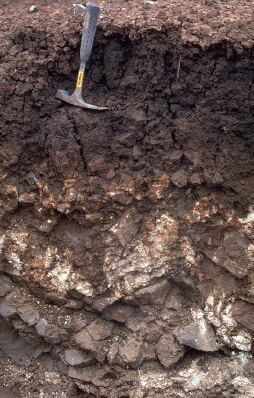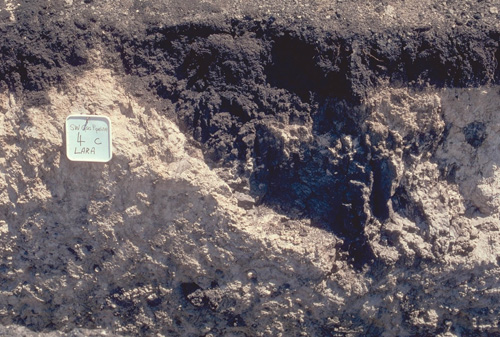SW102
Location: Lara
Australian Soil Classification: Epihypersodic - Endocalcareous, Epidedal Brown VERTOSOL
General Landscape Description: Level plain to very gently undulating plain.
Site Description: Flat elevated position within plain.
Geology: Basalt.
Soil Profile Morphology:
Surface Soil
| Ap | 0-10 cm | Dark yellowish brown (10YR3/4 moist); yellowish brown (10YR5/4 dry); light clay (fine sandy); pH 6.0; clear and smooth change to: |  SW102 Profile - Note: Surface stripped from soil profile. |
| Subsoil | |||
| B21t | 10-30 cm | Very dark greyish brown (10YR3/2); medium clay; fine prismatic to blocky structure; pH 8.3; clear and wavy change to: | |
| B22t | 30-40 cm | Reddish brown (5YR4/3); medium heavy clay; prismatic parting to angular blocky structure; some slickensides; pH 9.2; clear and wavy change to: | |
| B23k/C | 40 cm+ | Soft calcium carbonate (CaCO3); coarse (20-100 mm) fractured angular basalt becoming larger with depth. |
Key Profile Features:
- Coarsely structured surface horizon.
- Vertic features (slickensides) in subsoil.
- Calcium carbonate segregations in deeper subsoil.
- Moderate soil profile depth – overlying weathering verticular basalt.
Soil Profile Characteristics:
pH | Salinity Rating | |||
Surface (A1 horizon) | Moderately Acid | Low | Sodic | None1 |
Subsoil (B21 horizon) | Moderately Alkaline | Low-Medium | Strongly Sodic | Strong-Complete |
Deeper Subsoil (at 30-45 cm) | Very Strongly Alkaline | Medium | Strongly Sodic | Strong-Complete |
| 1 Strong dispersion after remoulding. | ||||

| The surface is moderately acid. The subsoil is moderately alkaline becoming very strongly alkaline at depth. | Salinity rating is low in the surface and upper subsoil becoming moderate in the deeper subsoil. | The soil is sodic in the surface and strongly sodic in the subsoil. | The clay content is high throughout the profile. |
Horizon | Sample Depth (cm) | pH (water) | pH (CaCl2) | EC 1:5 | NaCl % | Exchangeable Cations | |||
Ca | Mg | K | Na | ||||||
meq/100g | |||||||||
AP | 0-10 | 6 | 5.1 | 0.23 | 3.9 | 6.2 | 1.4 | 2.2 | |
B21 | 15-30 | 8.3 | 7.3 | 0.44 | 0.05 | 6.4 | 12 | 2.1 | 8.4 |
B22 | 30-45 | 9.2 | 8.6 | 0.75 | 0.06 | 6.4 | 16 | 2.3 | 12 |
Horizon | Sample Depth (cm) | Nitrogen % | Organic Carbon % | Exchangeable Aluminium mg/kg | Exchangeable Acidity meq/100g | Field Capacity pF2.5 | Wilting Point pF4.2 | Coarse Sand (0.2- 2.0 mm) | Fine Sand (0.02- 0.2 mm) | Silt (0.002- 0.02 mm) | Clay (<0.002 mm) |
AP | 0-10 | 0.27 | 2.8 | <10 | 14 | 31.3 | 15.4 | 9 | 27 | 18 | 38 |
B21 | 15-30 | 57 | 28.9 | 5 | 14 | 12 | 64 | ||||
B22 | 30-45 | 62.3 | 33.9 | 4 | 12 | 13 | 64 |
Management Considerations:
Surface (A) Horizons
- Tillage of cracking clay soils should be avoided if the soil is wet (i.e. wetter than the plastic limit). At such moisture conditions, excessive tillage, trafficking or over stocking could result in structural damage (i.e. compaction, smearing occurring). Tillage and trafficking should take place when the soil is drier than the plastic limit.
- The surface soil is sodic and disperses completely after remoulding. Care should be taken to avoid disturbing the surface horizon (i.e. trafficking, tillage, over-stocking) when the soil is in a moist condition. Also, raindrop impact on bare soil will exacerbate the hardsetting nature of the soil and will result in surface sealing and/or crust development.
- The subsoil is strongly sodic and disperses strongly. This is likely to significantly restrict root and water movement into the subsoil.
Further West from site:
- Continuing west the soils are as before (dark brown over calcium carbonate (CaCO3) but incidence of slickensides increases as lower ground is reached. Self mulching soil occurs in lower slope and flat (have not been described). Slickensides at greater than 1 m and clay for full depth of trench (2 m).

Profile Described By: Richard McEwan (January 1999).


